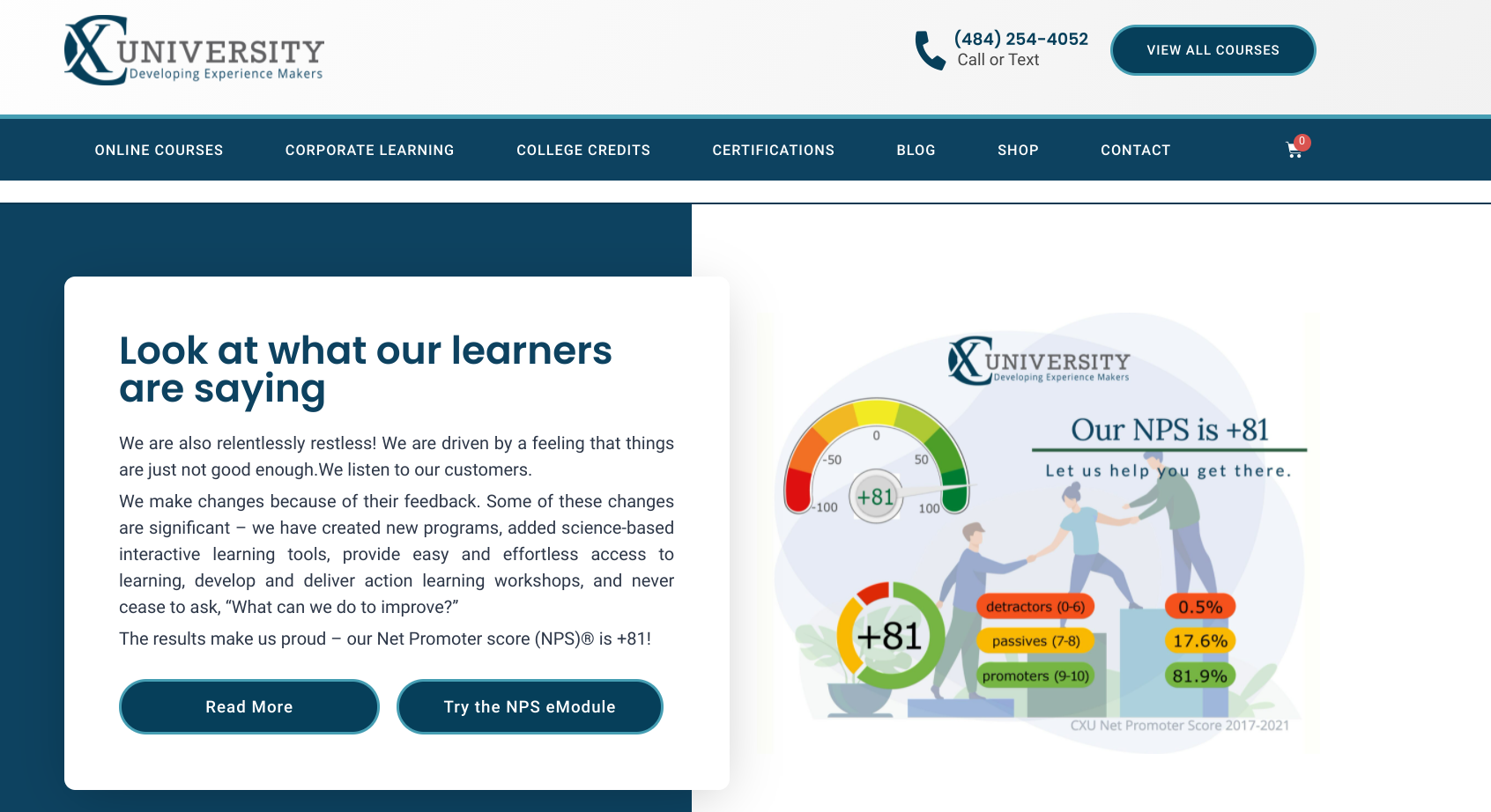The ability to deliver a good customer experience isn’t innate. Delivering a good customer experience requires strong listening skills, the ability to improvise, and empathy to solve customers’ problems. And because those skills aren’t innate, you have to put your contact center agents through customer experience training.
But it’s not just customer service agents that need this training. All of your departments, from sales and marketing to development and support, are part of the customer’s journey—so they should be a part of the training in CX as well. If your team isn’t prepared to meet customers’ needs, it could have devastating consequences for your business. According to research by Microsoft, 58% of consumers will change companies because of a poor customer experience.
Here’s how to run practical customer experience training so your whole company can deliver the best service possible to clients.
1. Leverage paid CX training resources.
Optimizing CX training for your team starts by providing them with the material they need for success. Here are some of the best training resources you can use to help agents improve how they service customers:
Conduct CX workshops
You can hire a consulting firm to host live training workshops to improve various aspects of their customer experience skills. Here are some ideas of different customer experience workshops you can conduct:
- Journey mapping—During a journey mapping workshop, you’re training your CX team to identify pain points and examine the different steps that the customer takes in their journey. The workshop helps them better understand your customer persona.
- Feedback mapping—The goal of feedback mapping workshops is to teach your team all the different ways they can gather feedback from customers. Your CX agents will learn how they can improve their listening and empathy skills.
- CX vision workshop—This workshop explains the importance of a CX vision, how to define it, and how to integrate the vision as part of your culture. These workshops can be done across teams for a fully integrated approach.
Invest in a learning management system (LMS).
A learning management system (LMS) is a cloud-based software that handles all your CX team’s training material in one place and takes employees through modules for a building-blocks-style approach to learning.
What’s great about an LMS for your customer experience team is that employees can have unlimited access to training material from anywhere in the world, at any time.
Another benefit is that an LMS allows you to track your learners’ progress easily. From the platform’s reporting dashboard, you can view how many users passed or failed your course and at which point of the lesson users feel stuck. This way you can be sure all teams have viewed the same training and are on the same page.
Sign up for CX University.
CX University offers specialized customer experience training on various subjects to improve the service of your support team. One aspect that makes CX University stand out from other learning platforms is that agents can also use its online certifications as college credits.
Source: CX University
Top CX leaders run each class on the platform across various topics of expertise. That said, the courses can be costly, ranging from $400 to more than $2,000.
2. Conduct role-play exercises to prepare teams for customer requests.
Role-play exercises simulate real conversations with customers, allowing teams to practice conversations and make mistakes in a low-stakes environment.
After each role-play exercise, you can review their performance and provide them with feedback on where they could improve. It helps teach your customer experience agents empathy by putting them in the customer’s shoes so they can understand their needs.
Here are examples of scenarios that you can get your customer experience agents to walk through so that they can practice handling the various customer requests coming their way:
Scenario #1: The customer is angry or impatient.
Dealing with angry customers is part and parcel of being a support agent. The customer could be angry due to a software bug or the inability to complete a specific task with the product. This scenario aims to see how the agent responds to adversity and helps them develop empathy skills.
Scenario #2: The customer makes a feature request.
It can be common for customers to request features they want to see in your products or services. Sometimes, these feature requests can provide solid feedback on what your company can do to improve its product, while other requests could be impossible to implement.
The best way customer experience agents can respond to this request is to acknowledge the feedback. Then they can explain whether it’s something that you plan on releasing in the future and why.
Scenario #3: The customer violates your company’s terms of service.
Your company may have various terms of service conditions that customers must respect. If a customer doesn’t respect the terms of service, support agents must politely let the customer know without assuming that they have bad intentions. After all, they could just be making a mistake without realizing it.
3. Codify a standard operating procedure (SOP).
You should codify a standard operating procedure for a variety of customer experience scenarios an agent or team might face. That way, all agents will handle situations similarly and deliver a consistent experience to your customers.
A standard operating procedure (SOP) is a set of directions and repeatable processes that your team uses to optimize the customer experience. For example, an SOP can include information on the ideal response time for a customer request or how to protect private data from customers.
As you’re training your teams, an SOP provides them with more clarity on their roles and serves as a document they can always go back to if they have any questions or roadblocks. It helps new hires get the most out of their training and reduces errors.
To create your SOP for customer service, you’ll have to include your most experienced and successful support agents as part of the process. Their insights will be valuable in outlining best practices for the entire team to follow.
Also, remember to update your customer service SOP from time to time to reflect the changes in your company or customer expectations.
4. Organize a mentor shadowing program.
When onboarding new hires to your customer experience team, you can implement a mentor shadowing program to quickly get them up to speed. Mentor programs are also a great way to integrate the new hire into your company culture.
Creating a mentorship program for customer experience agents consists of two steps. First, you have to outline what your mentorship program will look like. Identify which tools you’ll be using, your expectations for the new hire during their onboarding, how long the mentorship program will last, and how you’ll be tracking progress.
Next, you need to identify who will be the ideal mentors in your shadowing program. You must filter participants based on their experience, strengths, and success in the workplace, so they’re the best fit to onboard new hires.
5. Include improvisation exercises to improve conversation skills.
Improvisation exercises don’t just benefit theater actors. They also help support agents and other team members to improve their conversational skills and make each communication with the customer more human, relying less on (often robotic) scripts.
Here are examples of exercises you can use across teams, so they can improve their improvisation skills:
“Yes, and…”
One customer agent starts off with one sentence while the other agent has to expand on it with another sentence. This exercise forces the support agent to listen clearly to what the other agent has to say, so they can follow up with something clever, improving their listening skills as a result.
Same letter, new sentence
This improv exercise is similar to “yes, and…,” with the added difference that the customer agent has to say a new sentence that starts with the previous sentence’s last letter. It adds extra difficulty to ensure that the agent focuses and listens to every word said.
Never say never
The goal of the improv exercise is to train customer experience agents to decline questions and requests without saying a hard “no.” You create a list of unreasonable requests that you assign to agents during the improv session and get them to decline the request without saying no to the question.
Summing up
Investing in training helps increase your agents’ job satisfaction and efficiency, which, in turn, delivers a better experience to your customers, boosting loyalty. But it can also be used for other departments to learn and develop new skills in satisfying customers.
That said, training is one part of the equation. To ensure your support team can do their best when serving customers, give them tools that tee up each customer interaction.
Remove hold times by offering a callback service to ease customer tensions on the phone. Keep them from having to reach the IVR altogether by offering online call scheduling. And make sure the agent is provided as much context as possible—web or app journey, verification info received via SMS while waiting in queue— and the customer has as smooth a journey as possible to provide the very best experiences.






